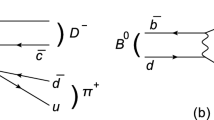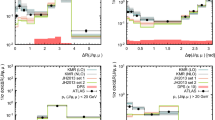Abstract
Muon inclusive multihadronic final states ine + e − annihilation at\(\langle \sqrt s \rangle \)=34.6 GeV, collected by the JADE detector at PETRA, have been analysed in terms of the semi-muonic branching ratios and fragmentation functions of heavy quarks. Defining the fragmentation variable, ζ, as\(z = \frac{{\left( {E + p_\parallel } \right)_{hadron} }}{{\left( {E + p} \right)_{quark} }}\) we find <z c >=(77±3±5)% and <z b >=(86±4±5)%. The corresponding semi-muonic branching ratios are measured to be BR(c→μv μ X)=7.8±1.5±2)% and BR (b→μv μ X)=(11.7±1.6±1.5)%. Defining ζ as\(x_E = \frac{{E_{hadron} }}{{E_{beam} }}\) we observe an expected softening effect in the fragmentation due mainly to gluon emission, but find that this definition leads to semi-muonic branching ratiomeasurements which are strongly affected by uncertainties in the fragmentation process and the WCD calculation.
Similar content being viewed by others
References
See for example E. Reya: Phys. Rep.69, 195 (1981); A.H. Mueller: Phys. Rep.73, 237 (1981); G. Altarelli: Phys. Rep.81, 1 (1982); D.W. Duke, R.G. Roberts: Phys. Rep.120, 276 (1985)
Ya.I. Azimov et al.: Leningrad preprint LNPI-222 (1976); M. Suzuki: Phys. Lett.71 B, 139 (1977); J.D. Bjorken: Phys. Rev.D 17, 171 (1978)
R.D. Field, R.P. Feynman: Nucl. Phys.B136, 1 (1978)
P. Hoyer, et al.: Nucl. Phys.B161, 349 (1979)
A. Ali et al.: Phys. Lett.93 B, 155 (1980)
B. Anderson et al.: Phys. Rep.97, 33 (1983); Z. Phys. C-Particles and Fields20, 317 (1983); T. Sjöstrand: Comp. Phys. Commun.27, 243 (1982);28, 229 (1983)
M. Bowler: Z. Phys. C-Particles and Fields11, 169 (1981)
C. Peterson et al.: Phys. Rev.D27, 105 (1983)
J.M. Izen: DESY 84-104 (1984)
S. Bethke: Z. Phys. C-Particles and Fields29, 175 (1985)
S. Bethke: International Symposium on the Production and Decay of Heavy Hadrons. Heidelberg (1986); HD-PY 86/07 (1986)
JADE Collab. W. Bartel et al.: Z. Phys. C-Particles and Fields25, 231 (1984)
JADE Collab W. Bartel et al.: Phys. Lett.114 B, 7 (1982). The variable used here does not include the factorE cm /E vis
R. Marshall: Z. Phys. C-Particles and Fields29, 175 (1984); (JADE Collab. W. Bartel et al.: Phys. Lett.146 B, 437 (1984)
JADE Collab. W. Bartel et al.: Phys. Lett.160 B, 337 (1985)
JADE Collab. W. Bartel et al.: Phys. Lett.160 B 277 (1985)
M. K. Gaillard et al.: Rev. Mod. Phys.47, 277 (1975); J. Ellis et al.: nucl. Phys.B100, 313 (1975); A. Pais, S.B. Treiman: Phys. Rev.D 15, 2529 (1977)
For a review of lifetime measurements see W.T. Ford: Aspen Winter Physics Conference, 1985. Ed. M. Block; COLO-HEP-87 (1985)
MARK III Collab. R.M. Baltrusaitis et al.: Phys. Rev. Lett.54 1976 (1985)
For a comprehensive bibliography list see references within: ARGUS Collab. H. Albrecht et al.: Phys. Lett.158 B, 525 (1985)
J.P. Leveille: Proceedings of the 2nd Moriond Workshop. Eds. J. Tran Thanh Van, L. Montanet, p. 191. Gif-sur-Yvette.: Editions Frontières, 1982
C. Jarlskog: Proceedings of the International Europhysics Conference on High Energy Physics, Eds. J. Guy, C. Costain, p. 768. Brighton (1983)
S. Stone: Proceedings of the 1983 International Symposium on Lepton and Photon Interactions at High Energies. Eds. D.G. Cassel, D.L., Kreinick, p. 203 (Newman Lab., Cornell University, Ithaca, 1983)
E.H. Thorndike: Ann. Rev. Nucl. Part. Sci.35, 195 (1985)
Current world average BR(b→lv 1 X) at ψ(4S) resonance: (11.8±0.5)%, and in the continuum (taking all PETRA and PEP results): (12.9±0.8)%
JADE Collab. W. Bartel et al: Phys. Lett.88 B 171 (1979);92 B, 206 (1980);99B, 277 (1981)
JADE Collab. W. Bartel et al.: Phys. Lett129 B, 145 (1983)
J. Allison et al.: Nucl. Instrum. MethodsA238, 220 (1985)
J. Allison et al.: Nucl. Instrum. Methods.A238, 230 (1985)
J. Olsson et al.: Nucl. Instrum. Methods176, 403 (1980)
\(\frac{{b \to u}}{{b \to c}}\) limited to (a)<0.3 fromK, D 0,D +,D *+, yields (CLEO), (b)<0.08 (conservative value) or<0.04 (probable value) from inclusive lepton spectra (CLEO, CUSB), E.H. Thorndike, International Symposium on Lepton and Photon Interactions, Kyoto (1985) p. 406; UR-935 (1986)
Current world average BR\(BR\left( {\tau \to \mu \bar v_\mu v_\tau } \right) = \left( {17.1 \pm 1.3} \right)\% \)
JADE Collab. W. Bartel et al.: DESY 86-086 (1986); submitted to Z. Phys. Particles and Fields
The background from pion punch-through can be experimentally determined by selecting 3 prong decays of tau leptons, which provide a pure source of pions, and subjecting them to the muon selection criteria. the π→μ decay contribution, is determined from the Monte Carlo simulation and subtracted from the results. Processes mimicking the 3 prong topology are also accounted for. The pion punch-through probability between the momentum range. 1.8<p(π)<9.0 GeV , is then obtained and compared with Monte Carlo predictions: Data: (0.93±0.25)% Monte Carlo: (0.98±0.05)%
TASSO, Collab. M. Althoff et al.: Z. Phys. C-Particles and Fields22, 219 (1984). In calculating the world averages for <z q > we use 349-3 and 349-4 which reflect the values of 349-5 quoted in Table 2, J.A. Thomas, Ph.D. Thesis, University of Oxford (1984)
TASSO Collab. M. Althoff et al.: Phys. Lett.146B, 443 (1984)
MARK J Collab. B. Adeva et al.: Phys. Rev. Lett.51, 443 (1983). Updated results (as in Tables 2 and 3) from: F.P. Poschmann, Ph.D. Thesis, University of Aachen (1985)
MAC Collab. B. Fernandez et al.: Phys. Rev. Lett.50, 2054 (1983). Updated results on the semi-muonic branching ratios (as in Table 3) from [39]
M. Piccolo: Proceedings of the 11th SLAC Summer Institute on, Particle Physics, Ed. P.M. McDonough. Stanford, California, SLAC Report No. 267, p. 673 (1983)
MARK II Collab. M.E. Nelson et al.: Phys. Rev. Lett.50, 1542 (1983); Updated results (as in Tables 2 and 3) from [41]
N. Lockyer: Proceedings of the 11th SLAC Summer Institute on Particle Physics, Ed. P.M. McDonough. Stanford California, (1983) SLAC Report No. 267, p. 689; SLAC-3245 (1983)
DELCO Collab. D.E. Koop et al.: Phys. Rev. Lett.52, 970 (1983) Here ζ-xy i.e. (7). Updated results (as in Tables 2 and 3) from: T. Pal et al., CALT-68-1283 (1985). Here ζ-xE i.e. (5)
TPC Collab. H. Aihara et al.: Phys. Rev.D31, 2719 (1985)
TPC Collab. H. Aihara et al.: Z. Phys. C-Particles and Fields27, 39 (1985)
CELLO Collab. H.J. Behrend et al.: Z. Phys. C-Particles and Fields19, 291 (1983)
S. Weseler: Ph.D. Thesis, University of Heidelberg (1986)
CLEO Collab. K. Chadwick et al.: Phys. Rev.D27, 475 (1983)
CUSB Collab. G. Levman et al.: Phys. Lett.141B 271 (1984)
CUSB Collab. C. Klopfenstein et al.: Phys. Lett.130B, 444 (1983)
DELCO Collab. W. Bacino et al.: Phys. Rev. Lett.43, 1073 (1979). See also [56]
LGW Collab. J.M. Feller et al.: Phys. Rev. Lett.40, 274 (1978). See also [56]
MARK II Collab. R.H. Schindler et al.: Phys. Rev.D24, 78 (1981)
LGW Collab. J.M. Feller et al.: Phys. Rev. Lett.40, 1677 (1978). See also [56]
DASP Collab. R. Brandelik et al.: Phys. Lett.70B, 125 (1977);70B, 387 (1977); See also B.H. Wiik, G. Wolf: DESY 78-023 (1978) and [56]
A. Soni: Phys. Rev. Lett.53, 1407 (1984)
For a review see: G.H. Trilling: Phys. Rep.75C, 57 (1981)
Author information
Authors and Affiliations
Consortia
Rights and permissions
About this article
Cite this article
JADE Collaboration., Bartel, W., Becker, L. et al. Determination of semi-muonic branching ratios and fragmentation functions of heavy quarks ine + e − annihilation at\(\langle \sqrt s \rangle \)=34.6 GeV. Z. Phys. C - Particles and Fields 33, 339–349 (1987). https://doi.org/10.1007/BF01552539
Received:
Issue Date:
DOI: https://doi.org/10.1007/BF01552539




